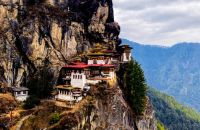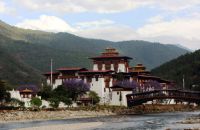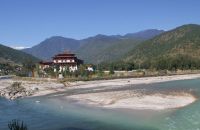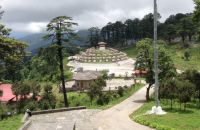Talk with our local travel specialist who can help organize your trip.
Dos and Don'ts While Visiting Bhutan
Holidays are meant to be fun, relaxing, and inspiring. But one should never forget to be conscious and respectful of the country's rules, regulations, and customs. A good traveler is one who is culturally sensitive and abides by the rules of their holiday destination. There is a set of ‘dos and don'ts ’that every traveler needs to follow while traveling to any country for safety as well as for an enriching experience.
Destination Bhutan
Bhutan is a beautiful country in the eastern Himalayas and one of the most rarely explored holiday destinations. Nestled deep in the snow-covered Himalayan mountains, this small country is regarded as a champion of environmental conservation and sustainable tourism. In its policies, the Bhutanese government puts emphasis on the contentment and happiness of the citizens rather than material wealth.
While other countries have a Gross Domestic Product, Bhutan has a Gross Happiness Index to measure its growth and prosperity. The government of Bhutan has also made it a rule to keep sixty percent of the country's total land area covered by forests. Following the principles of Vajrayana Buddhism, the main religion of the kingdom, the Bhutanese make an effort to protect and care for all sentient or living beings in the country.
Bhutan is a deeply religious country. The country’s ancient Buddhist heritage and traditions make it a fascinating destination. If you have chosen Bhutan as your holiday destination, here are some dos and don'ts while visiting Bhutan.
Table of Content
Dos and Don'ts While Visiting Bhutan
Let's start with the dos.
-
Be mindful of religious practices while visiting temples and monasteries.
- Always wear appropriate clothes that cover your body. It is disrespectful to wear skimpy outfits while visiting religious sites. Also, takeoff your hat and sunglasses while visiting the inner sanctum of the temple or monastery.
- Always use your right hand while offering or accepting something. It's better to use both hands while receiving something.
- Walk clockwise while circumambulating churches or religious structures. Keep to the right and use your right hand while spinning prayer wheels.
- Buy handicrafts, but not antiques. Bhutan prohibits the export of any antiques. Only buy items that have been certified for sale and export.
- Keep an open mind and be ready to try out new experiences and foods to make your trip more memorable.
- Do ask people for permission before photographing them.
- Carry medications for altitude sickness, common cold, diarrhea, etc. Also, carry medication for motion sickness if you feel nauseous while riding on winding roads with many twists and turns.
- Inform your tour guide if you have any serious health issues or allergies so that he or she will know exactly what to do if there's a medical emergency.
- Pack noise-cancellation earbuds with you. There are many stray dogs around Paro and Thimphuthat put up a ruckus during the night. The constant barking at night can disturb your sleep. Wearing noise-cancellation earbuds might ensure a quiet and relaxing sleep.
- Have an umbrella or raincoat with you if you are traveling during the rainy season. Not only during the monsoon season, you can expect scattered rainfall and thundershowers, even during the spring and autumn seasons.
- If you are planning to use your debit or credit card while traveling, make sure that the international transactions are activated on your bank card. But do keep in mind not all business establishments in Bhutan accept card payments. So you should always have some local currency with you while traveling.
- In remote towns and villages, there are hardly any ATMs or banks. So make sure you have local currency while traveling away from the cities.
Featured Trips
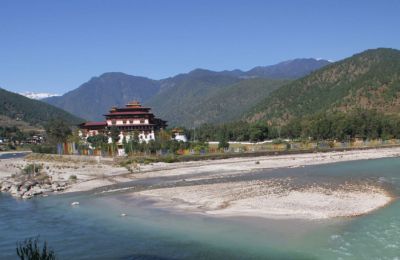
Bhutan Cultural Tour - 5 days
Bhutan Cultural Tour of 5 days lets you discover the rich Bhutanese culture. Visit ancient fortresses and Taktsang Monastery. Enjoy traditional hot stone bath.
Inquire Now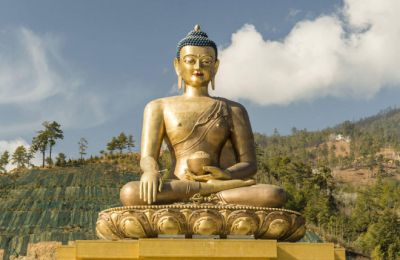
Bhutan Heritage Tour - 8 days
Bhutan Heritage Tour lets you explore centuries-old dzongs and Lakhangs built by Bhutanese kings and spiritual leaders. Take this Bhutan Heritage Tour and journey across the cultural hotspots of Bhutan, a fascinating Himalayan kingdom.
Inquire NowWhere to travel next?
Get help from our travel specialists for holiday ideas that matches your interests.
Now here's a list of 'don'ts' that a visitor should strictly follow while in the Land of the Thunder Dragon.
-
Do not try to explore the country on your own. Independent travel is banned in the country, and the government of Bhutan mandates that all tourists should travel with a government-licensed guide. This has been done to preserve the country's fragile culture and ecosystem.
- Do not indulge in things or activities that could disturb the local setting or the cultural values of the Bhutanese people.
- Never use your finger to point at a religious structure. Either use your palm or gesture with your chin.
- Do not climb, set foot, or sit on mani stones, chortens, or stupas. These are religious structures, and touching them with your feet or any lower part of the body is considered sacrilegious and disrespectful.
- Don't try to pet stray dogs.
- Do not roam around in the streets at night. There are stray dogs that roam around in packs in the towns and cities at night, and they might try to bite you.
- Do not try to climb mountains. Climbing or setting foot on the mountains is strictly prohibited, as the locals worship the mountains and regard them as guardian deities.
- Don't smoke in public. Bhutan is the only country that has banned the production and sale of tobacco. Even though tourists are allowed to bring two hundred cigarettes when they enter Bhutan, smoking is only permitted in some private areas and is strictly banned in public places. If you wish to smoke, do so in spaces where smoking is allowed. You can ask your guide where you can smoke and where you cannot.
- Do not make fun of the phallic symbols, sacred Tantric paintings, or statues that are sexually explicit. These are part of the Buddhist traditions in Bhutan, and locals don't appreciate it when their religion is mocked.
- Do not take photographs where photography and filming are strictly prohibited. Most religious places forbid filming and photography inside their premises, and tourists should abide by the rules.
- Do not wash dirty objects or throw trash in water bodies.
Travel to Bhutan
If you have chosen Bhutan as your holiday destination, here's how you can go about planning your trip.
- Get a Bhutan visa. You can get your visa online, or your tour operator will arrange it for you. It costs USD 40 to get a Bhutan visa. The nationals of Bangladesh, India, and the Maldives do not need a visa to enter Bhutan. However, they need to have a valid passport (for Indians, a voter's ID card is sufficient for identity proof).
- Book your tour with a government-registered travel agency.
- Make sure your passport has six months of validity before entering Bhutan.
- Book a flight from any of the hubs that share connectivity with Bhutan. You can also enter the country via the Indo-Bhutan land border.
- Make sure to pack clothes that are weather and activity-appropriate.
What is SDF, and why are tourists made to pay this fee?
SDF, or Sustainable Development Fee, is an amount that tourists have to pay while visiting Bhutan. This amount goes towards funding the free healthcare, education, and infrastructure development projects that the Bhutanese government runs across the country. The fee collected from tourists also goes to finance projects on sustainability and upskilling youth.
As of 2024, the per-day Sustainable Development Fee is fixed at USD 100. Children between the ages of 12 and 5 can avail of a 50 percent concession, and children below the age of 5 are exempt from paying the fee. For Indian tourists, the amount is much lower, and the daily fee has been fixed at INR 1200 per day
One of the prime reasons for levying the Sustainable Development Fee on tourists by the Bhutanese government is to avoid over-tourism and protect the environment. Bhutan is a tiny country with a small population, and if the inflow of foreign tourists is not restricted, the country's tourism service sector will get overwhelmed, and there might be adverse effects on the country's culture and environment through outside influence.
Best places to visit in Bhutan
The major cities of Paro, Thimphu, and Punakha are the main hubs for tourists. However, your holiday destination in Bhutan depends on the activities you would like to engage in. For cultural tours, Thimphu, Paro, Punakha, and Gangtey are the best destinations.
If you are interested in trekking and hiking, you can head further into the foothills of the remote mountains and walk on the isolated Himalayan trails. Druk Path Trek, Jomolhari Trek, Dagala Thousand Lakes Trek, Haa Valley Trek, Laya Gasa Trek, and The Snowman Trek are the most popular treks in Bhutan. The Trans Bhutan Trek, which involves walking through the country from west to east, is one of the longest and toughest treks in this part of the Himalayas. The total distance of the trail is 500 kilometers.
There are also short hikes like the famous Tiger's Nest or Taktsang Monastery Hike, Gangtey Nature TrailHike, Khunsum Yuelley Chorten Hike, Cheri Gompa Hike, Dodeydra Monastery Hike, Lungchutse LakhangHike, etc..
If you are into mountain biking, then you will surely love riding through the ups and downs and rough trails of Bhutan's biking trails. You will be crossing high mountain passes, quaint villages, and amazing Himalayan scenery.
Bhutan has trails for all levels of bikers. The biking trail between Thimphu, Punakha, and Gangtey is fairly easy and can be done by all levels of bikers. If you are up for a challenge, then you can choose the more difficult (steep and rocky) route that leads right up to the remote villages of eastern Bhutan.
For wildlife lovers, Bhutan has national parks that are home to exotic and endangered species of Himalayan wildlife and vegetation. The red panda, snow leopard, one-horned rhinoceros, royal Bengal tiger, golden langur, Himalayan black bear, blue sheep, clouded leopard, etc. are some of the endangered wild animals found in this country. Bhutan also offers a safe haven for a staggering 770species of birds. The Royal Manas National Park, Wangchuck Centennial National Park, Jigme Dorji National Park, Bomdeling Wildlife Sanctuary, etc. are some of the wildlife parks and sanctuaries where you can enjoy a wildlife adventure.
The Motithang Wildlife Preserve in Thimphu is dedicated to preserving and protecting the national animal of Bhutan, the takins. Takin, a unique animal that looks like a mix between a moose and a goat, are found only in some parts of Asia.
The mountain lakes and thundering glacial rivers offer amazing opportunities for fishing and river rafting expeditions. The pristine water bodies of Bhutan are home to more than a hundred species of fish, including snow trout, brown trout, and golden masher.
For fishing, you need a special permit, which can be arranged by the agency you book your tour with. Trophy fishing is prohibited, and as per Buddhist principles, the catch-and-release practice of fishing is encouraged. For fishing expeditions, you should be accompanied by a guide and have the required permit. Fishing during breeding seasons and on some religious days is not allowed. The rivers flowing through Haa, Paro, Thimphu, Tsirang, Trongsa, Bumthang, and Zhemgang are prime spots for fishing expeditions.
If you wish to ride on the fast-flowing rapids of the glacier-fed rivers in Bhutan, you can take a whitewater rafting or kayaking adventure. The rivers of Punakha, Paro, Bumthang, and Trongsa are popular for river rafting and kayaking activities.
When should you visit Bhutan?
Spring and autumn are the best seasons to visit Bhutan. During these seasons, the weather generally remains calm and pleasant. While the country can be visited throughout the year, the monsoon season and winter can pose a bit of a challenge. The monsoon season brings with it torrential rainfall and storms that can dampen your holiday spirit. Likewise, winter can be cold and chilly. As most of Bhutan lies above 1000 meters, there's snowfall in winter at most places. While the winter landscape has its own charm, one has to deal with extreme cold and freezing temperatures.
One can also time one's travel to Bhutan during one of its major festivals. Bhutan celebrates at least one festival each month. Most of the festivals are religious events and are held in the large courtyards of monasteries. The festivals run for several days, and the monastic community as well as the general public participate in these festivals.
The Buddhist religious festivals are vibrant and colorful. These festivals showcase the ancient and rich Tibetan Buddhist traditions marked by chams, or masked dances, religious skits, and ceremonious performances by monks. Most festivities end with a grand prayer ritual where monks pray for peace, harmony, and goodwill.
Some of the major festivals in Bhutan include the Tshechus, which are held in all the major dzongkhags or districts. Paro Tshechu, Thimphu Tshechu, Punakha Tshechu, and Gangtey Tshechu. BumthangTshechu and the Wangdue Phodrang are some of the important Tshechus celebrated in the country. TheTshechus are held at different times of the year in different places.
Apart from the Tshechus, the Jambay Lakhang Drup, Punakha Drubchen, Sakteng Festival, Gomphu Kora, and Losar are the other important festivals observed by the Bhutanese people.
Other than the regional festivals, the government of Bhutan has introduced certain festivals to promote tourism in the country. The Black Necked Crane Festival, the Royal Highland Festival, the Matsutake Mushroom Festival, the Haa Summer Festival, and the Jomolhari Mountain Festival are some of the delightful festivals held especially for tourists. These festivals showcase the rich cultural heritage and food habits of the people of Bhutan.
Featured Trips
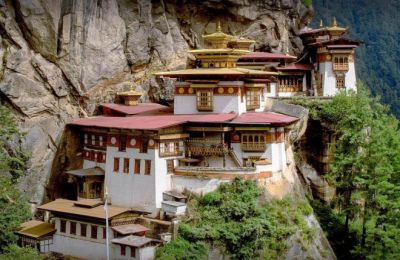
Nepal and Bhutan Tour - 9 days
Experience the beauty and culture of Nepal and Bhutan with our exclusive tour package for 2024/2025. Book now and create unforgettable memories!
Inquire Now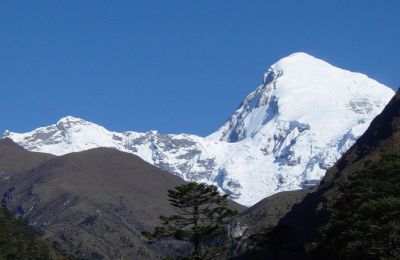
Jomolhari Trek - 11 days
Jomolhari Trek offers a taste of the great variety of Bhutanese landscapes and the most enchanting adventure trek in Bhutan. Jomolhari is the second-highest unclimbed mountain in Bhutan.
Inquire NowWhere to travel next?
Get help from our travel specialists for holiday ideas that matches your interests.
Facts you should know about Bhutan
- Bhutan is a tiny landlocked country located deep within the Himalayan Range. Its immediate neighbors are China and India, and it shares its land borders with both of these countries. Compared to its neighbors, Bhutan has a really small territory. It covers an area of 38,394 square kilometers and is 150 km wide and 350 km long. The elevation in the country is as low as 160 meters along the plains of the Indian border and as high as7570 meters along the high mountainous zone of the Bhutan-Tibet border.
- The country has a constitutional democracy where the king is the head of the country and the executive power is vested in the council of ministers led by the prime minister. For centuries, Bhutan followed a policy of isolation and was cut off from the outside world. It was only in 1974 that this remote Himalayan country opened its doors to tourists.
- The official language of Bhutan is Dzongkha. However, English, Hindi, and Nepali are also spoken widely and understood by a large majority of Bhutanese. Most Bhutanese are Vajrayana Buddhists, and thus it is the official religion of the country. Religion plays a big role in the lives of the Bhutanese, and the Je Khenpo, the chief abbot or chief religious head of the Monastic Affairs Commission, wields a lot of power. He is seen as the chief advisor to the King of Bhutan.
- The currency of Bhutan is the Ngultrum. The only two foreign currencies accepted in Bhutan are the American or US dollar and the Indian rupee. However, 500 and 2000 Indian rupee notes are not accepted in Bhutan. 1 USD is roughly equal to 83 Bhutanese Ngultrum (as of 2024). The value of Bhutanese Ngultrum is almost equivalent to the Indian rupee.
- As per Bhutanese law, seventy percent of its total land area should be covered by forests. That is why one will be surrounded by greenery wherever one goes in Bhutan. Generally, people live offof farming and agriculture. But the new generation of Bhutanese who are educated are taking up modern professions. Most Bhutanese working in the tourism sector can communicate in English.
- It may sound unbelievablebutBhutan is the only country in the world which doesn’t have a single traffic light. Being a tiny country with a small population, the roads in Bhutan rarely see a traffic jam. Traffic in cities like Thimphu and Paro is managed by traffic police, and roundabouts on the roads have been built for easy navigation for drivers.
- Chili peppers are used as vegetables and are an integral part of Bhutanese cuisine.
- Bhutan is one of the few countries where you will see people wearing traditional attire every day. Wearing traditional costumes is compulsory for government employees as well as students. However, many ordinary Bhutanese citizens who are not in government service also prefer to wear their traditional outfits (Gho for men and Kira for ladies)daily, even though it's not mandatory for them.
- Bhutan is a carbon-negative country. It is one of the only three carbon-negative countries in the world. Panama and Suriname are the only three countries in the world that are carbon-negative: that is, they produce more oxygen than carbon dioxide.
Conclusion
Bhutan is a unique country that has preserved its age-old traditions and culture. A visit to this country will let you experience the peace, harmony, and Buddhist spiritualism that prevail here. The pristine nature and cultural experiences that you can enjoy in this country are truly remarkable. This is a country where you can feel a deep connection with the natural world and become aware of your inner self. Be conscious of the local rules and cultural etiquette if you wish to make your visit to this peaceful and idyllic destination in the Himalayas memorable. Being aware of the local 'dos and don'ts' while visiting Bhutan will make your experience enriching and memorable.
- Written by: Naba Raj Amgai
Updated: Jun, 9, 2024






